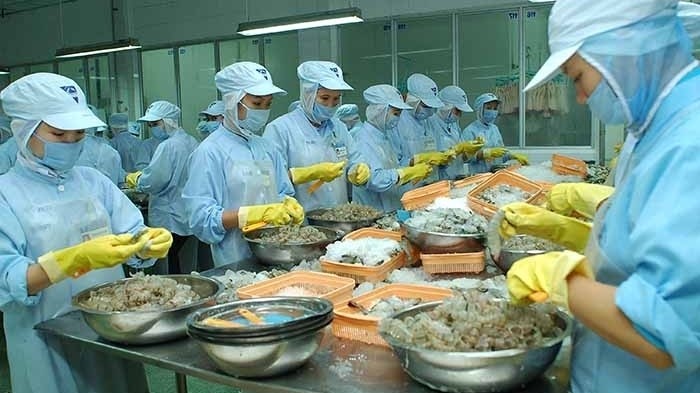New record established
Minh Phu Seafood Corporation is the largest shrimp farming and processing company in Vietnam and also one of the largest shrimp exporters in the world. The 2018 export turnover of Minh Phu increased by 20% compared to 2017 thanks to the company's closed farming and processing model and the application of high technology on a large scale, helping to boosts its exports.
According to the Directorate of Fisheries, Vietnam's aquatic export revenue was estimated to reach US$9 billion in 2018, a year-on-year increase of 8.4%. In particular, almost all aquatic products saw a rise in export revenues compared to 2017.
Specifically, tra fish (shark catfish) posted export revenue of US$2.26 billion, up 26.4%, while shrimp export revenue reached US$3.58 billion, down 7.1% and seafood, including tuna, reported an export revenue of US$675 million, up 13.9% over 2017.
2018 was a challenging year for the aquatic sector. Unusual weather conditions caused great difficulties for aquatic production in addition to the strengthened control over food quality and safety from Vietnam's main export markets including the US, the EU, Saudi Arabia, the Republic of Korea, and others. In particular, the EU’s application of a "yellow card" warning measure for Vietnamese seafood products exported to the EU also caused difficulties for Vietnam's seafood industry.
Nguyen Hoai Nam, Deputy General Secretary of the Vietnam Association of Seafood Exporters and Producers (VASEP), said that the US$9 billion-export turnover demonstrated the professionalism in implementing strategies and responding to technical barriers by both State management agencies and enterprises.
Deep processing and increasing value of aquatic products
The Directorate of Fisheries will work to bring the 2017 Fisheries Law to life, with the goal of increasing production values in 2019 by 4.25% compared to 2018, reaching a total aquatic output of 7.9 million tonnes and total aquatic export turnover of US$10 billion. Shrimp and tra fish will continue to be the two main products of the aquatic industry.
However, Deputy General Director of the Directorate of Fisheries, Tran Dinh Luan, warned that the aquatic sector is currently facing many challenges including climate change and small-scale production. In addition, a number of markets are increasing protectionism and building technical barriers to limit aquatic imports from other countries.
Minister of Agriculture and Rural Development, Nguyen Xuan Cuong, said that the aquatic sector needs to make great effort to achieve the target of US$10 billion in export turnover in 2019. The sector must work to remove the EU’s application of the "yellow card" warning measures for Vietnamese seafood in order to regain trust from customers.
Futhermore, the sector should re-evaluate its organisational structure and boost the sustainable development of key farming products, including catfish and brackish shrimp, while applying high-technology to the farming and processing of aquatic products.
Phan Thanh Loc, vice chairman of the board of directors at Vietnam Food JSC, said that Vietnam produces an estimated more than 500,000 tonnes of by-products of shrimp each year, which could generate nearly US$2 billion with the use of advanced technology but Vietnam can only create approximately US$300 million. The main reason is the weakness in technology, machinery and equipment, as well as commercial strategies.
Loc noted that if the by-products are not processed, they will immediately lose value and pose a threat to the environment. If we have orientations to commercialise by-products, it will bring great value to the aquatic sector, while contributing to protecting the environment and shifting the economy to deep processing.
Therefore, the aquatic sector needs to invest in science and technology and make the best use of available materials to turn them into value-added products to serve the people and the health sector.
“Skin of tra fish is a source of raw materials for collecting collagen to serve high-class customers. In addition, studies found that some parts of tra fish such as bone powder, nano calcium powder and fish oil products can be converted into supplements or cosmetic products. In the future, we will work with enterprises to study to produce such products,” said Tran Dinh Luan.
Luan also emphasised the importance of market expansion for new products which requires the support of a number of agencies, particularly Vietnamese counsellor agencies abroad in order to help products gain access to foreign markets in a quick and effective manner.
















